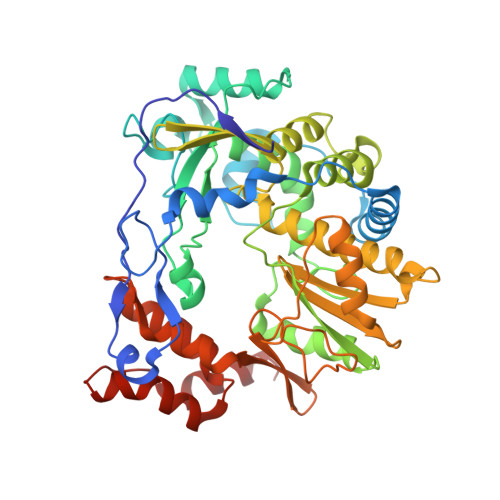The RNA Template Channel of the RNA-Dependent RNA Polymerase as a Target for Development of Antiviral Therapy of Multiple Genera within a Virus Family.
van der Linden, L., Vives-Adrian, L., Selisko, B., Ferrer-Orta, C., Liu, X., Lanke, K., Ulferts, R., De Palma, A.M., Tanchis, F., Goris, N., Lefebvre, D., De Clercq, K., Leyssen, P., Lacroix, C., Purstinger, G., Coutard, B., Canard, B., Boehr, D.D., Arnold, J.J., Cameron, C.E., Verdaguer, N., Neyts, J., van Kuppeveld, F.J.(2015) PLoS Pathog 11: e1004733-e1004733
- PubMed: 25799064
- DOI: https://doi.org/10.1371/journal.ppat.1004733
- Primary Citation of Related Structures:
4Y2A, 4Y2C, 4Y34, 4Y3C - PubMed Abstract:
The genus Enterovirus of the family Picornaviridae contains many important human pathogens (e.g., poliovirus, coxsackievirus, rhinovirus, and enterovirus 71) for which no antiviral drugs are available. The viral RNA-dependent RNA polymerase is an attractive target for antiviral therapy. Nucleoside-based inhibitors have broad-spectrum activity but often exhibit off-target effects. Most non-nucleoside inhibitors (NNIs) target surface cavities, which are structurally more flexible than the nucleotide-binding pocket, and hence have a more narrow spectrum of activity and are more prone to resistance development. Here, we report a novel NNI, GPC-N114 (2,2'-[(4-chloro-1,2-phenylene)bis(oxy)]bis(5-nitro-benzonitrile)) with broad-spectrum activity against enteroviruses and cardioviruses (another genus in the picornavirus family). Surprisingly, coxsackievirus B3 (CVB3) and poliovirus displayed a high genetic barrier to resistance against GPC-N114. By contrast, EMCV, a cardiovirus, rapidly acquired resistance due to mutations in 3Dpol. In vitro polymerase activity assays showed that GPC-N114 i) inhibited the elongation activity of recombinant CVB3 and EMCV 3Dpol, (ii) had reduced activity against EMCV 3Dpol with the resistance mutations, and (iii) was most efficient in inhibiting 3Dpol when added before the RNA template-primer duplex. Elucidation of a crystal structure of the inhibitor bound to CVB3 3Dpol confirmed the RNA-binding channel as the target for GPC-N114. Docking studies of the compound into the crystal structures of the compound-resistant EMCV 3Dpol mutants suggested that the resistant phenotype is due to subtle changes that interfere with the binding of GPC-N114 but not of the RNA template-primer. In conclusion, this study presents the first NNI that targets the RNA template channel of the picornavirus polymerase and identifies a new pocket that can be used for the design of broad-spectrum inhibitors. Moreover, this study provides important new insight into the plasticity of picornavirus polymerases at the template binding site.
Organizational Affiliation:
Department of Medical Microbiology, Radboud Institute for Molecular Life Sciences, Radboud University Medical Centre, Nijmegen, The Netherlands; Laboratory of Virology and Chemotherapy, Rega Institute for Medical Research, University of Leuven, Leuven, Belgium.















